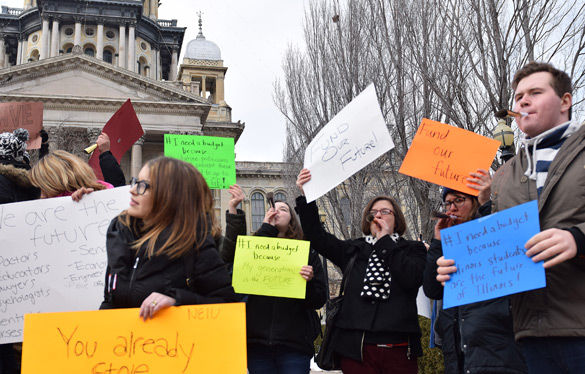Illinois colleges in cash flow ‘hell’

February 29, 2016
Illinois’ failure to pass a budget is failing its colleges.
As the impasse between Republican Gov. Bruce Rauner and the Democratic legislature nears its ninth month, shutting off hundreds of millions of dollars for higher education, public universities are raiding reserves, deferring projects and planning to lay off employees.
Chicago State University canceled spring break to finish the semester before cash runs out and said Friday that the entire faculty and staff may be let go. Last week, Moody’s Investors Service downgraded three universities, pushing one to junk, the first time an Illinois college has fallen so low.
Advertisement
“What I call that is the cash flow challenge from hell,” said Elaine Maimon, president of Governors State University, which received $24 million of state aid last year, or about 45 percent of its budget. “There has to be some coming together of the governor and the general assembly. You can’t just disestablish your public universities.”
The state’s higher-education system is emerging as one of the biggest victims of the record-long budget stalemate in Illinois, whose chronic fiscal strains have left it with a lower credit rating than any other state. While money has kept flowing to school districts, employee paychecks and debt payments, its spending for universities and colleges — which totaled about $1.9 billion last year — has disappeared entirely.
Rauner supports a bill introduced last week that would provide $200 million of emergency funding, according to Catherine Kelly, his spokeswoman. The measure relies on letting the state keep money it’s borrowed from funds earmarked for other purposes.
The governor this month vetoed a $721 million bill for community colleges and scholarships for low-income students that the schools have been covering themselves. He laid out two options: make changes to Illinois’s procurement process to free up half a billion dollars or give him the legal authority to make other budget cuts.
“We can’t just send the money that we don’t have,” Rauner told reporters in Chicago on Feb. 22. “That’s not an option.”
Without the state aid, the pressure is building. The eight public universities in the state that Moody’s rates, which have a combined $3.2 billion of debt, all have negative outlooks, indicating their rankings may be cut.
On Feb. 24, the company downgraded Eastern Illinois University, Northern Illinois University and Northeastern Illinois University. Some Eastern bonds were dropped to Ba3, making it one of just four public colleges with debt rated below investment grade.
Advertisement*
When Western Illinois University sold $9 million of bonds last month, investors demanded yields of 2.6 percent on securities due in April 2024, in line with the lowest investment-grade debt, even though they were insured against the risk of default.
“It’s really serious,” said Diane Viacava, a Moody’s analyst who tracks Illinois universities. The schools “are going through a lot of stress, trying to cope, trying to manage their cash flow to meet all the obligations.”
Eastern is laying off almost 200 employees and may idle others by implementing furloughs from March through June. It had expected to receive about $40 million from the state for its operations this year and as much as $9 million to cover scholarships for low-income students, according to President David Glassman.
Not all are feeling it equally. University of Illinois, whose three campuses serve more than 80,000 students, has “significant flexibility” to manage through the impasse, according to Moody’s, which kept the fourth-highest rating on that school last week.
The longer the standoff goes on, though, the more serious it will become, said Timothy Killeen, University of Illinois’ president. It has put construction projects on hold, deferred maintenance and delayed filling empty positions, he said.
At this point in the year, the state would have normally paid the university about $671 million.
“We’re not crying wolf, and we’re not trying to alarm people,” Killeen said. “This is a threat to the excellence of the University of Illinois, and as time goes on, it’ll cut deeper and deeper.”
In February, Chicago State, where 70 percent of students rely on financial aid, declared financial exigency, a move allowing for emergency budget cuts. To meet March’s payroll, the administration has already slashed headcount by 15 percent, or 174 employees and is considering closing some buildings, spokesman Tom Wogan said.
Even if a budget passes, that may not put an end to the pressure. Rauner’s proposed spending plan for the year that starts in July would reduce higher-education funding about 20 percent from 2015 levels while offering some performance-based grants.
Rauner has faulted the Democrats who run the legislature for failing to come up with a plan to balance the budget, which has left the state poised to have a more than $4 billion deficit this year, using up money that could have gone to colleges. The ongoing budget crisis and the prospect of more cutbacks could lead high-school graduates to look outside the state, analysts said.
Enrollment “is the lifeblood of many of these institutions,” said Dan Heckman, a senior fixed-income strategist at U.S. Bank Wealth Management, which oversees $125 billion, including some Illinois university debt. “Students want to go to educational institutions that they know are going to be there four to five years at graduation time.”
_________
(c) 2016 Bloomberg News
Visit Bloomberg News at www.bloomberg.com
Distributed by Tribune Content Agency, LLC.
Advertisement






